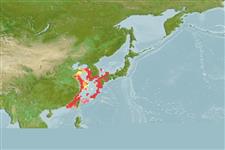>
Clupeiformes (Herrings) >
Dorosomatidae (Gizzard shads and sardinellas)
Etymology: Sardinella: Latin and Greek, sarda = sardine; name related to the island of Sardinia; diminutive (Ref. 45335).
More on author: Bleeker.
Environment: milieu / climate zone / depth range / distribution range
Ecologia
marinhas; oceanódromo (Ref. 51243); intervalo de profundidade 5 - ? m (Ref. 12166). Subtropical; 38°N - 22°N, 117°E - 134°E (Ref. 54873)
Western Pacific: southern coasts of Japan south to about Taiwan.
Tamanho / Peso / Idade
Maturity: Lm ? range ? - ? cm
Max length : 18.0 cm TL macho/indeterminado; (Ref. 56557); common length : 10.0 cm SL macho/indeterminado; (Ref. 188)
Espinhos dorsais (total): 0; Espinhos anais 0. Total scutes 29 to 32. Vertical striae on scales overlapping or continuous (discontinuous in S. fimbriata and S. albella), only a few small perforations on hind part of scale. No dark spot at dorsal fin origin. Most closely resembles S. richardsoni, which has more gill rakers and has a slightly deeper body; S. hualiensis has black tips to dorsal and caudal fins.
Found near shore, including semi-enclosed sea areas, on sandy mud bottom (Ref. 11230). Forms schools in coastal waters. Used in Chinese medicine (Ref. 12166).
Whitehead, P.J.P., 1985. FAO Species Catalogue. Vol. 7. Clupeoid fishes of the world (suborder Clupeoidei). An annotated and illustrated catalogue of the herrings, sardines, pilchards, sprats, shads, anchovies and wolf-herrings. FAO Fish. Synop. 125(7/1):1-303. Rome: FAO. (Ref. 188)
Categoria na Lista Vermelha da IUCN (Ref. 130435)
Ameaça para o homem
Harmless
Utilização humana
Pescarias: altamente comercial
Mais informação
ReferênciasAquaculturaPerfil para aquaculturaEstirpesGenéticaElectrophoresesHereditariedadeDoençasProcessamentoNutrientsMass conversion
ColaboradoresFotografiasStamps, Coins Misc.SonsCiguateraVelocidadeTipo de nataçãoÁrea branquialOutras referênciasCérebrosVisão
Ferramentas
Relatórios especiais
Descarregue XML
Fontes da internet
Estimates based on models
Preferred temperature (Ref.
123201): 13 - 24.7, mean 19.7 °C (based on 72 cells).
Phylogenetic diversity index (Ref.
82804): PD
50 = 0.5000 [Uniqueness, from 0.5 = low to 2.0 = high].
Bayesian length-weight: a=0.01230 (0.00694 - 0.02182), b=3.06 (2.91 - 3.21), in cm total length, based on LWR estimates for this species & Genus-body shape (Ref.
93245).
Nível Trófico (Ref.
69278): 3.2 ±0.3 se; based on diet studies.
Generation time: 2.2 ( na - na) years. Estimated as median ln(3)/K based on 2
growth studies.
Resiliência (Ref.
120179): Elevada, tempo mínimo de duplicação da população menor que 15 meses (tm=1).
Fishing Vulnerability (Ref.
59153): Low vulnerability (22 of 100).
Climate Vulnerability (Ref.
125649): High vulnerability (63 of 100).
Nutrients (Ref.
124155): Calcium = 159 [86, 301] mg/100g; Iron = 1.78 [1.05, 3.19] mg/100g; Protein = 21.2 [20.2, 22.1] %; Omega3 = 0.475 [0.231, 0.905] g/100g; Selenium = 40.5 [21.3, 76.6] μg/100g; VitaminA = 22.7 [6.8, 75.7] μg/100g; Zinc = 0.796 [0.579, 1.188] mg/100g (wet weight);
